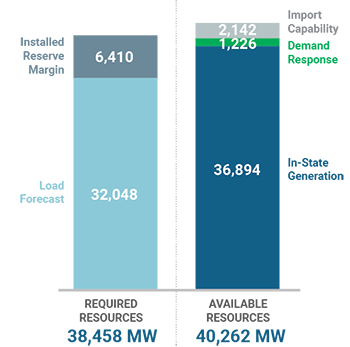Energy vs. Capacity: How Teamwork Between Markets Supports a Least-Cost Approach to Grid Reliability

Maintaining a reliable energy system requires that enough power generating capacity is installed system-wide to meet projected electricity demand and reliability requirements.
In order to meet the complex needs of managing the energy grid, the NYISO operates multiple markets that work together to achieve a reliable system with the lowest cost resources available. The cost to produce energy and the cost of procuring adequate capacity are both included within the cost of wholesale electricity, but the NYISO manages a separate market for each to support their different purposes.
Projections based on historical data help the NYISO predict how much generation will be required to meet demand on a given day. Extreme weather events, increased demand to power air conditioning during a sustained period of unusually hot weather, or an out-of-service transmission line or generating facility, can create tighter conditions between demand and supply. Having an ample supply of reserves at the ready for these circumstances enables the NYISO to provide electricity to the hospitals, public transit systems, schools, homes, and businesses that are essential to society and the livelihoods of New Yorkers. Meeting consumer demand in all scenarios is the heart of grid reliability.
Each of the NYISO’s markets are interdependent, and facilitate a different piece of the reliability puzzle:
- The function of the energy market is to secure enough power supply for the system to meet demand in real-time;
- The ancillary market maintains balance on the electrical grid, and;
- The capacity market secures supply to meet resource adequacy requirements.
Wholesale electricity markets in New York minimize costs and support reliability
The NYISO’s energy market provides a fundamental platform for utilities, large consumers, competitive energy suppliers, and load serving entities to purchase quantities of electricity from the generators that participate as sellers in the NYISO marketplace. Put simply, the energy market provides a means for load serving entities to satisfy the immediate power needs of the customers they serve.
While some electricity is bought and sold directly between suppliers and utilities, much of the electricity consumed in New York is procured through the wholesale electricity markets administered by the NYISO. In these markets, suppliers compete to offer electric supply and ancillary services necessary to maintain reliability. Every five minutes, every day, these markets select the least-cost mix of supply to meet changing electricity demand across the state, all while adhering to strict reliability standards. After being selected in these auctions, generators deliver their services to the marketplace. Several factors influence which suppliers are selected for their services, including the location of generators, and the amount of electricity flowing across the grid.
Future demand must be anticipated, and resources must be ready to perform
The NYISO’s highest priority is to maintain reliability of the electric system, and in keeping with our mission, the NYISO operates the capacity market to meet resource adequacy requirements and other reliability requirements. The purpose of the capacity market is to create a marketplace for utilities to procure enough resource capacity to reliably meet peak demand plus a reserve margin. Forecasted peak load is over 32,000 MW for Summer 2023, and utilities must serve demand even if unplanned constraints unexpectedly reduce the pool of power generation options.
The capacity market acts as a transparent and cost-effective mechanism to avoid the danger of service interruptions and outages, by compensating qualifying suppliers who choose to participate, including traditional generation, solar, wind, and battery storage, to be available to provide power when needed.
Reliability rules mandate a percentage of capacity reserves, determined by extensive analysis

(Source: 2023 Power Trends Report)
Strict reliability rules require extra capacity to be available in excess of expected peak demand, so demand can be met reliably even when unforeseen events occur like transmission or generation outages, or additional demand from hotter than expected weather. This requirement to maintain extra supply among the pool of resources interconnected to the grid is called the Installed Reserve Margin (IRM). The IRM percentage is set annually by the New York State Reliability Council (NYSRC), based on reliability rules, annual peak demand projections, grid constraints, and the makeup of the supply mix anticipated to meet demand. Developing the IRM is an extensive study process that unfolds over much of the year. The IRM is based on updated load, resource, and transmission models. It is derived by engineers, meteorologists, and economists, using strict reliability rules, engagement with industry stakeholders, and oversight from regulators. Inputs include information from NYISO planning, which evaluates changes in forecasted demand, supply performance capabilities, and transmission system constraints. The NYSRC submits the final IRM for review and approval to both the New York Public Service Commission (PSC) and the Federal Energy Regulatory Commission (FERC). The added security of the IRM provides options in circumstances where power supply to consumers may otherwise be interrupted due to a deficit of supply.
Regular capacity auctions facilitate the amount of available future supply
The NYISO’s capacity auctions are conducted on a seasonal and monthly basis. There are three types of capacity auctions in the NYISO markets. Seasonal auctions are held for both summer (May through October) and winter (November through April) periods, and the NYISO conducts two types of monthly capacity auctions: one in which buyers and sellers trade capacity, and a final auction designed to ensure that capacity procurement obligations are met. A resource that qualifies its capacity must demonstrate its capability and can bid such an amount of capacity into these auctions. In addition to conventional resources, renewable energy, demand response, and energy storage resources can qualify to provide capacity.
National challenges to meeting capacity needs
Not every region in the U.S. uses this mechanism to support reliability for customers. For example, Texas and California do not operate capacity markets. Due to a multitude of factors including the challenges of coordinating the pace of renewable energy integration with the retirement of fossil resources, and the onset of uncharacteristic regional weather patterns, both states are beginning to consider capacity market-like structures to address reliability going forward. For example, in 2022, the grid operator in California, CAISO, extended special contracts through the end of 2023 with a handful of fossil-fuel power plants that were scheduled to retire, which both compensate and require the plants to remain in operation. This type of contract is only utilized in scenarios where concerns about availability of supply are very high, and the risk of capacity shortages is significant.
Rather than relying on this approach, which is meant for last-resort scenarios, the NYISO’s capacity market provides built-in security to the marketplace for energy that leverages principles of competition to ensure that supply is not only available, but also that the cost of that supply is as competitive as possible for the benefit of consumers.
The NYISO’s capacity market reinforces the health, safety, and welfare of all New Yorkers in a clean energy future
The power grid is the lifeblood of the daily lives of New Yorkers and the state’s economy. The reality is, when consumer demand surges, the power must come from somewhere, and meeting that demand at the lowest possible cost is central to the NYISO’s mission. Building in reserve requirements on top of peak demand expectations into the NYISO’s market-based supply procurement approaches ensures that the necessary level of supply is available, supporting the safety and welfare of the state’s inhabitants and businesses, especially vulnerable populations.
As New York progresses towards the mandates established by the Climate Leadership and Community Protection Act (CLCPA), extensive technical considerations must be prioritized in running a complex electrical grid system 24-hours per day, 7 days per week, 365 days per year. Creating supply procurement mechanisms that align with those technical considerations is paramount to reliably delivering power to consumers, so that the resources required to meet New Yorkers’ needs are available and ready to perform when needed.
Key operational differences between fossil fuel assets and intermittent renewable energy generation are underscoring the need for retaining resources that provide specific attributes of dispatchability and flexibility. Intensifying climate-driven weather events, growth in electricity usage from electric vehicles and heat-pumps requires that the transition towards a zero-emissions grid be managed carefully until storage and other clean tech resources can be viable substitutes for fossil fuel plants. While this development advances forward to cultivate adequate replacements for the fossil plants that are currently necessary during high demand or unstable periods, the NYISO capacity market continues to offer an essential marketplace to procure dependable resources to keep communities and businesses powered every step of the way.
